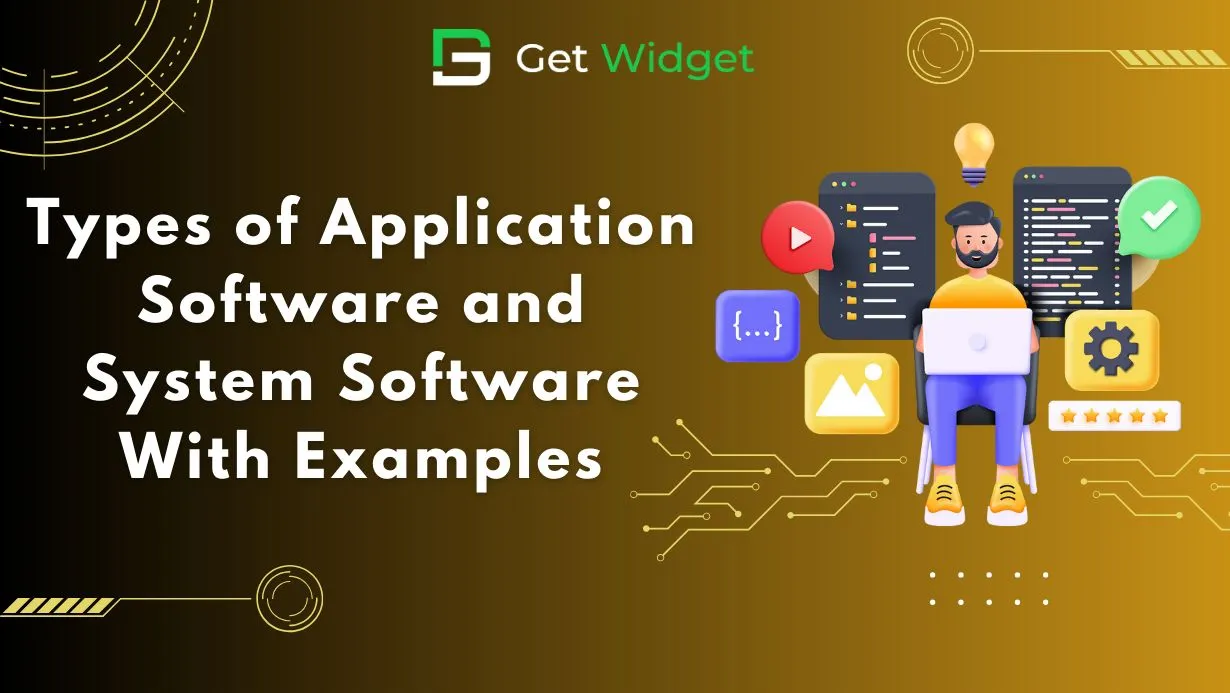Application software refers to computer programs or software applications that are designed to perform specific tasks or functions for users. These programs are created to meet various needs, such as productivity, entertainment, education, graphics, communication, and utility.
Importance of Application Software in Today’s Digital World
Application software plays a crucial role in our daily lives and the digital landscape.
Here are some reasons why it is important:
- Enhances Productivity: Application software like productivity tools (e.g., Microsoft Office, Google Workspace) helps individuals and businesses streamline their work processes, create documents, manage data, and collaborate effectively.
- Provides Entertainment: Entertainment software, such as Netflix and Spotify, offers a wide range of content for users to enjoy movies, TV shows, music, and more, providing entertainment and relaxation.
- Facilitates Education: Educational software like Khan Academy and Duolingo provides interactive learning experiences, making education more accessible and engaging for learners of all ages.
- Enables Graphic Design: Graphics software such as Adobe Photoshop and Canva empowers users to create and edit images, illustrations, and designs, catering to the needs of UI/UX graphic designers, artists, and photographers.
- Supports Communication: Communication software like Skype and Slack enables individuals and teams to connect, collaborate, and communicate seamlessly, regardless of geographical barriers.
- Offers Utility Functions: Utility software, including antivirus programs and file compression tools, helps users optimize their computer systems, protect against malware, and manage files efficiently.
Application software differs from system software, which is responsible for managing and operating computer hardware. Application software is designed to serve specific user needs, while system software ensures the overall functioning of the computer system.
In today’s digital world, application software has become an integral part of our personal and professional lives, enhancing productivity, entertainment, education, creativity, communication, and utility functions. It continues to evolve and shape the way we interact with technology and accomplish tasks efficiently. Moreover, we frequently encounter numerous software development trends that automate business operations and foster growth.
What is Software?
To grasp the concept of application software, it is essential to have a solid understanding of software’s true definition and its various types.
Software refers to a set of instructions, programs, or data that enable a computer or other electronic device to perform specific tasks or functions. It encompasses the applications, programs, and operating systems that run on computers and other devices. Software allows users to interact with hardware, control system operations, run applications, process data, and perform a wide range of tasks based on the instructions provided. There are two main categories of software: system software, which includes operating systems and utilities that manage computer hardware, and application software, which consists of programs designed to carry out specific tasks for users. Software is essential for the functioning of modern technology and plays a crucial role in various aspects of our daily lives, from productivity and communication to entertainment and education.
System Software and Application Software:
Understanding the Differences System software and application software are two distinct categories of software that serve different purposes.
Here are the key differences between them:
System Software:
- System software is the foundational software that manages and controls the computer hardware and provides a platform for running other software.
- It includes operating systems like Windows, macOS, and Linux, which manage computer resources and provide a user interface.
- System software also includes device drivers, which enable communication between hardware devices and the operating system.
- Its primary function is to facilitate the operation of the computer system itself rather than specific tasks or applications.
Application Software:
- Application software refers to programs designed to perform specific tasks or provide specific functionality for end-users.
- Examples of application software include web browsers, word processors, spreadsheet programs, photo editing software, and video games.
- Unlike system software, application software is not essential for the basic functioning of the computer system.
- Application software is typically developed to meet the needs of users in various domains, such as productivity, entertainment, communication, and education.
In summary, system software is responsible for managing the computer system, while application software is designed to fulfill specific user needs and tasks.
What is System Software?
System software is a type of software designed to provide a platform for running application software and to manage computer hardware resources. Here are some key points about system software:
Foundation: System software serves as the foundation for the computer system, enabling communication between hardware components and other software applications.
Operating System: One of the most essential components of system software is the operating system (OS), such as Windows, macOS, Linux, and Unix. The operating system manages hardware resources, provides a user interface, and facilitates communication between software and hardware components.
Device Drivers: System software also includes device drivers, which are programs that enable communication between hardware devices (such as printers, scanners, and graphics cards) and the operating system.
Control and Management: System software controls and manages the basic operations of the computer system, including memory management, process management, file management, and security.
In essence, system software plays a crucial role in ensuring the proper functioning of a computer system by managing hardware resources and providing a platform for running application software.
What is Application Software?
Application software refers to programs designed to perform specific tasks or provide specific functionality for end-users. Here are some key points about application software:
- Examples of application software include web browsers, word processors, spreadsheet programs, photo editing software, and video games.
- Application software is not essential for the basic functioning of the computer system, unlike system software.
- Application software is typically developed to meet the needs of users in various domains, such as productivity, entertainment, communication, and education.
- It is designed to fulfill specific user needs and tasks, providing functionality and features that cater to specific purposes.
- Application software can be installed and run on top of the system software, utilizing the platform provided by the operating system.
- Users interact directly with application software to perform tasks, create content, or access specific services.
In summary, application software is the software that users interact with directly to perform specific tasks or access specific functionality on their computers or mobile devices. Without any delay, let’s explore various categories of application software.
Types of Application Software
1. Productivity Software
When it comes to productivity software, it is a category of application software that helps individuals and organizations perform tasks more efficiently and effectively. Here are some key points to describe productivity software further:
Functionality: Productivity software offers a range of tools and features to assist users in creating, editing, managing, and sharing various types of documents, spreadsheets, presentations, and more.
Collaboration: Many productivity software solutions support collaboration features, allowing multiple users to work on the same document simultaneously, share feedback, and track changes.
Integration: These applications often integrate with other software and services to streamline workflows. For example, productivity software may connect with email clients, cloud storage platforms, project management tools, and communication apps.
Customization: Users can often customize settings, templates, and layouts to suit their preferences and needs. This flexibility helps individuals tailor the software to enhance their productivity.
Cross-Platform Compatibility: Productivity software is typically available across various devices and operating systems, enabling users to access their work from desktop computers, laptops, tablets, and smartphones.Examples of productivity software include Microsoft Office (Word, Excel, PowerPoint), Google Workspace (Docs, Sheets, Slides), and other similar applications.
2. Entertainment Software
When it comes to entertainment software, it encompasses a diverse range of applications that cater to users’ leisure and recreational needs. Here are some additional details to further describe entertainment software:
Variety of Media: Entertainment software offers a wide variety of digital media content, including movies, TV shows, music, e-books, games, and more. Users can access an extensive library of content to suit their preferences and interests.
On-Demand Access: One of the key features of entertainment software is the provision of on-demand access to entertainment content. Users can stream or download their favorite media anytime, anywhere, based on their convenience.
Personalization: Many entertainment software platforms offer personalized recommendations based on users’ viewing or listening habits. This helps users discover new content that aligns with their tastes.
Offline Viewing/Listening: Some entertainment software allows users to download content for offline viewing or listening. This feature is beneficial for users who want to enjoy media without an internet connection.
Subscription Models: Entertainment software often operates on subscription-based models, providing users with access to a vast library of content for a monthly fee. This model offers convenience and affordability for consumers.
Social Features: Many entertainment software platforms incorporate social features that enable users to share their favorite content with friends, create playlists, follow others, and engage in discussions related to the media they consume.
Some Entertainment Software Examples:
Netflix:
Netflix is a popular streaming service that provides a vast collection of TV shows, movies, documentaries, and original content for subscribers to enjoy on-demand. In addition to Netflix, there are several other OTT platforms in India that offer a variety of content.
Spotify: A leading music streaming platform that allows users to listen to a vast library of songs, podcasts, and playlists from various artists and genres.
3. Educational Software
This type of software is designed to facilitate learning and skill development through interactive and engaging digital tools. Educational software aims to enhance educational experiences, provide personalized learning opportunities, and improve outcomes for students of all ages.
Some Educational Software Examples:
Khan Academy: An online learning app platform offering a wide range of educational resources, including video lessons, practice exercises, and assessments across subjects like math, science, history, and more. Khan Academy is known for its free and accessible educational content.
Duolingo: A popular language-learning app platform that uses gamification to help users learn languages through interactive lessons, quizzes, and challenges. Duolingo offers courses in multiple languages and is suitable for beginners to advanced learners.
Educational software is structured to support learning objectives, engage users through interactive content, and provide feedback to enhance understanding and retention of educational material.
4. Graphics Software
Graphics software refers to applications used to create, edit, manipulate, and enhance visual content such as images, illustrations, and designs. These tools are essential for graphic designers, artists, photographers, and anyone working with visual media.
Some Graphics Software Examples:
Adobe Photoshop: A powerful and versatile graphics editing software used for photo editing, unlimited graphic design, digital painting, and more. Photoshop offers a wide range of tools for image manipulation, compositing, and enhancement.
Canva: Canva is a user-friendly graphic design platform that allows users to create a variety of visual content, including social media graphics, presentations, posters, and more. It offers a vast library of templates, images, and design elements for users to customize their creations.
Graphics software enables users to unleash their creativity, express ideas visually, and produce professional-quality visual content for various purposes, such as marketing materials, digital art, branding, and more.
5. Communication Software
Communication software facilitates real-time or asynchronous communication between individuals or groups, enabling them to exchange messages, collaborate on projects, hold virtual meetings, and share information regardless of physical location.
Some Communication Software Examples:
Skype: Skype is a popular communication tool that allows users to make voice and video calls, send instant messages, share files, and conduct conference calls. It is widely used for personal and business communication purposes.
Slack: Slack is a team collaboration platform that offers channels for organized communication, file sharing, integration with other tools, and features like video calls and screen sharing. It is commonly used in professional settings to streamline communication within teams.
6. Utility Software
Utility software refers to programs designed to help manage, maintain, optimize, and enhance the performance of a computer system. These tools perform specific functions to assist users in tasks related to system management, security, data organization, and more.
Some Utility Software Examples:
Antivirus Programs: Antivirus software is a type of utility software that helps protect computers from malware, viruses, and other security threats. It scans the system for malicious software, blocks suspicious files, and provides real-time protection to prevent infections.
File Compression Tools: File compression software is another type of utility software that reduces the size of files or folders to save storage space and facilitate easier file transfer. Examples include WinZip, 7-Zip, and WinRAR, which compress files into smaller archives for efficient storage and sharing.
7. Investment Software:
Investment apps are a convenient way for individuals to manage their investments and stay updated on market trends on the go. With the help of these investment software you can decide where to invest money. Here are some popular investment apps and software that offer a range of features to help users make informed financial decisions:
Personal Capital: Apart from its web platform, Personal Capital also offers an investment app that allows users to track their finances, investments, and retirement accounts conveniently from their mobile devices.
Robinhood: Known for its commission-free trading, Robinhood’s investment app enables users to trade stocks, options, and cryptocurrencies easily and efficiently. It is popular among beginner investors due to its user-friendly interface.
Wealthfront: Wealthfront’s investment app serves as a robo-advisor, providing automated investment solutions tailored to users’ financial goals and risk tolerance. Users can access and manage their diversified portfolios through the app.
Acorns: This investment app focuses on micro-investing by rounding up your everyday purchases to invest the spare change. It helps users start investing with small amounts and build their portfolios over time.
Betterment: Betterment’s investment app offers personalized investment advice and automated portfolio management services. Users can set financial goals, track their progress, and make adjustments to their investment strategies through the app.
Examples of Popular Application Software
Here are some popular examples of application software along with a brief overview and their main features:
Microsoft Office (Word, Excel, PowerPoint):
Word: A word processing software used for creating and editing documents.
Excel: A spreadsheet software used for data analysis, calculations, and creating charts.
PowerPoint: A presentation software used for creating slideshows with multimedia elements.
Adobe Creative Cloud (Photoshop, Illustrator, Premiere Pro):
Photoshop: A powerful image editing software used for graphic design, photo editing, and digital art.
Illustrator: A vector graphics editor used for creating illustrations, logos, and graphics.
Premiere Pro: A video editing software used for professional video production and editing.
Zoom (Video conferencing):
Zoom is a popular video conferencing software that allows users to host and join virtual meetings, webinars, and online events. It offers features like screen sharing, chat, and recording.
Spotify (Music streaming):
Spotify is a music streaming platform that provides access to a vast library of songs, albums, and playlists. Users can create their own playlists, discover new music, and listen to music offline.
Google Chrome (Web browser):
Google Chrome is a web browser known for its speed, security, and user-friendly interface. It allows users to browse the internet, access websites, and use web applications.
WhatsApp (Messaging app):
WhatsApp is a messaging app that enables users to send text messages, make voice and video calls, share media files, and create group chats. It also offers end-to-end encryption for secure communication.
These applications serve various purposes and cater to different needs, ranging from productivity and creativity to communication and entertainment.
Discover a world of innovation with Getwidget! Explore our comprehensive services, including Flutter app development, Fullstack development, backend development, and frontend development. Let us help you bring your digital ideas to life and elevate your online presence!
Getwidget is a leading mobile app development company dedicated to developing top-notch application software for users worldwide. Our team is committed to delivering high-quality, user-friendly solutions that enhance productivity, creativity, and communication. With Getwidget, you can experience the power of seamless digital tools designed to simplify your life. Join us on this journey of innovation and exploration! Explore the top technology trends with Getwidget and embrace the future of technology.




